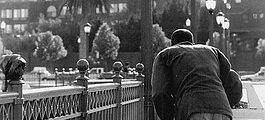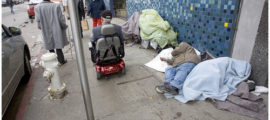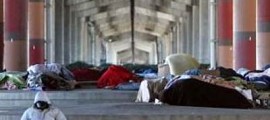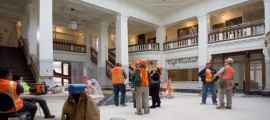Articles Tagged “Homelessness”
-
Giving Priority to Homeless with Mental and Health Conditions
The mentally ill and those with physical conditions should be a priority in any plan to homelessness in San Francisco.
-
San Francisco’s Intractable and Increasing Homeless Problem
Getting the homeless into housing or shelters has been a “concern” or a “priority” for every San Francisco administration. Yet, the number of homeless keeps rising.
-
City of Berkeley Seeks to Criminalize Homelessness
Nearly half of America is poor or “near-poor,” government statistics show—below or near the poverty line, barely making ends meet. Anywhere from 1.5 million to 3.5 million Americans are homeless, and one in six children go hungry. Yet here in Berkeley, California, one of the country’s most famously liberal cities, business leaders aim to fine homeless people $75 for sitting on the sidewalk in commercial strips.
-
Slipping Away: Mentally Ill Homeless Receive No Care
For the past three years, Irma Garcia has been battling far more than homelessness on the streets of South San Francisco. Garcia struggles with mental illness, including severe depression. Her greatest challenge, however, is the lack of a support system.
-
Living with Dignity: TNDC to Add 174 Units of Permanent Affordable Housing for Chronically Homeless
One hundred and seventy four chronically homeless individuals will soon be living with dignity in one of the Tenderloin’s most majestic buildings, thanks in large part to a public-private partnership between the City of San Francisco and the Tenderloin Neighborhood Development Corporation, a non-profit organization dedicated to ending homelessness through permanent, affordable and supportive housing.
-
US Government Continues to Neglect Returning War Veterans
The Department of Veterans Affairs has been severely criticized for the diagnoses of wounded veterans with a personality disorder, instead of PTSD, thus denying them disability pay and medical benefits. More than 22,500 soldiers have been suspiciously dismissed with personality disorders, rather than PTSD.
-
Bye Bye Buster
Buster’s Place, a drop-in center that offers a temporary respite for San Francisco’s homeless population, is slated for closure March 31 due to budget cuts. Photos by Luke Thomas By Nicholas Olczak March 25, 2008…









 The Hunger Site
The Hunger Site
Recent Comments